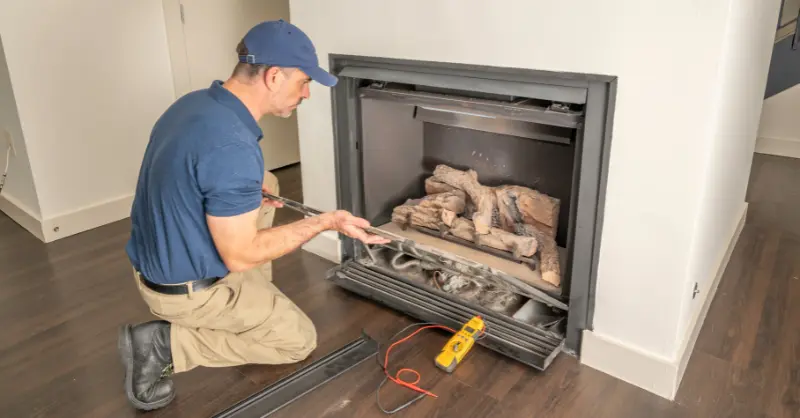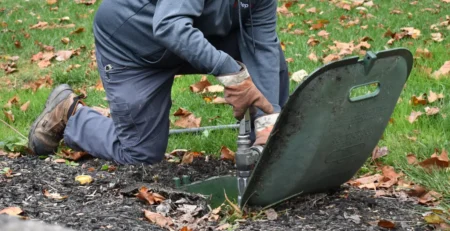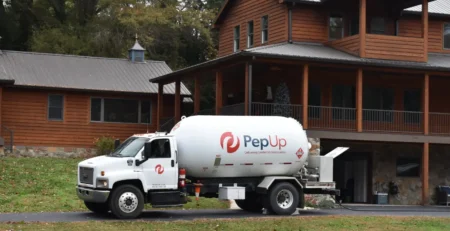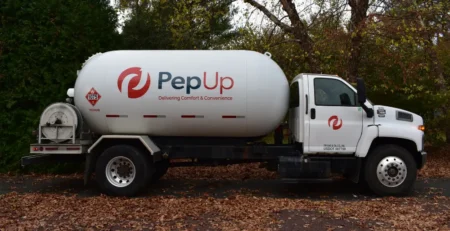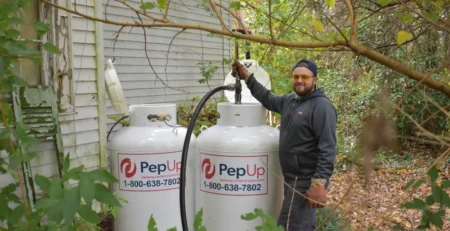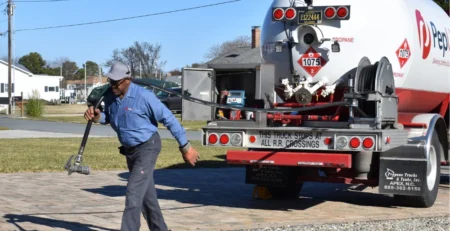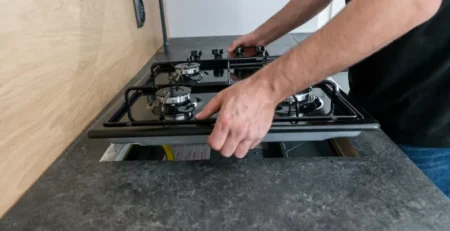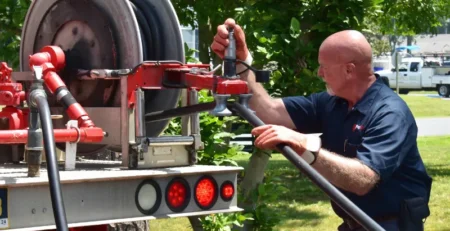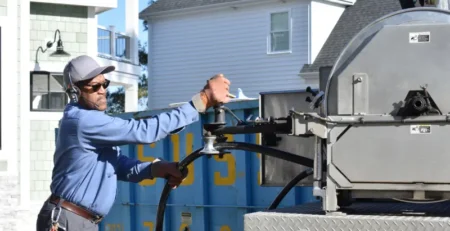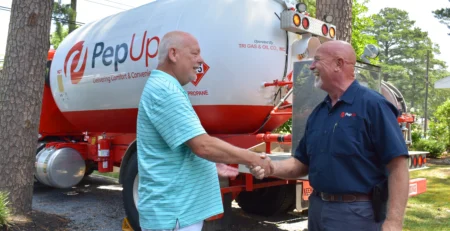Choosing the best propane fireplace insert for your home
A propane fireplace insert is a heat source that is designed to fit inside an existing wood-burning fireplace, although it can also be installed in a new build or an existing home without a fireplace. When you’re looking for an upgrade for your wood-burning fireplace, or a propane fireplace for a new build or renovation, use this guide to choose the best propane fireplace insert for your home.
Jump ahead to:
- What is a propane fireplace insert vs. a log set?
- VIDEO: View the Sassafras Refractory Gas Log Set by Empire Comfort Systems in action
- How do I light a fire in a propane fireplace?
- What kind of maintenance does a propane fireplace insert require?
- Are propane fireplaces realistic looking?
- How much propane does a fireplace insert use?
- Are propane fireplace inserts safe?
- Use this guide to create your fireplace shopping checklist
What is a propane fireplace insert vs. a log set?
A propane log set is designed to be placed inside an existing wood-burning fireplace. It consists of a burner and a set of ceramic logs. The logs sit on top of the burner, creating the appearance of a real wood fire. The burner is connected to a propane gas line, which provides fuel for the flames. Log sets can be easier to install in an existing wood-burning fireplace, converting it to a propane fireplace, but they’re less efficient at heating a room than a complete fireplace insert.
A propane fireplace insert is a self-contained heating appliance that is installed inside an existing fireplace opening or into framing designed for a propane fireplace. They provide warmth and can often heat larger areas or even entire rooms. The heat exchanger and blowers in the insert help distribute the heat more effectively, providing efficient heating and comfort instead of relying on radiating heat like a log set.
Here's the Sassafras Refractory Gas Log Set by Empire Comfort Systems, one of our best-selling gas log set models.
How do I light a fire in a propane fireplace?
Propane fireplace inserts come with various features, such as programmable thermostats, remote controls, and adjustable flame settings, allowing you to customize the heating experience according to your preferences. When you order a fireplace with a remote control, it’s easy to start a fire with just a button click or two, depending on how your fireplace moves heat into the room.
When you push the button on your remote or inside the control panel on the front of your fireplace, a pilot light ignites the propane connected to your log set, producing a flame that warms the heat exchanger. The heat exchanger then transfers the warmth into your living space through a fan or natural convection.
What kind of maintenance does a propane fireplace insert require?
One of the main advantages of a propane fireplace insert is its convenience. Unlike wood-burning fireplaces, it requires minimal setup and cleanup. There’s no need to gather firewood, and you won’t have to deal with ash, soot, or creosote. Once you’ve had it installed by a professional, you can be sure that your propane fireplace insert is properly connected to the LPG line, vented correctly, and meets all safety requirements.
Depending on the brand you choose, you may need to complete seasonal maintenance tasks that include cleaning propane orifices and testing your system. Hiring a professional to complete this maintenance once a year or so is much less hassle and mess than hiring a chimney sweep, so we think it’s worth the cost.
Are propane fireplaces realistic looking?
Propane fireplace inserts are great at heating a room, and they also offer the aesthetic appeal of a traditional fireplace. They often feature realistic-looking flames and logs, creating a cozy focal point in your living space.
Propane fireplace manufacturers pay special attention to creating a realistic and authentic wood-burning look in their fireplace designs using modern techniques that have come a long way in the past few decades.
- Log Sets: Propane fireplace inserts typically feature log sets made from fire-resistant materials like ceramic fibers or refractory cement. These log sets are meticulously crafted to resemble real wood logs, with textured bark, detailed wood grain, and charred portions. Some manufacturers even offer hand-painted log sets for enhanced realism.
- Flames: Manufacturers employ advanced technology to create lifelike flames in propane fireplaces. They use burners with specially designed ports or jets that provide an even distribution of gas, creating a natural-looking flame pattern. Some models incorporate different flame levels, allowing you to adjust the height and intensity of the flames to suit your preference. You can usually adjust the flame height using your remote.
- Ember Beds: Propane fireplaces often include ember beds placed at the base of the log sets. These ember beds consist of small, glowing ceramic pieces or fiber materials that mimic the glow and soft radiance of burning embers. The placement and arrangement of the embers further enhance the illusion of a real wood fire.
- Realistic Heat Distribution: To simulate the radiant heat emitted by wood-burning fires, manufacturers design propane fireplace inserts with heat exchangers. These components absorb heat from the flames and efficiently distribute it into the room through convection or fans. By mimicking the way heat naturally radiates from a wood fire, the propane fireplace insert creates a more authentic experience.
How much propane does a fireplace insert use?
Your home’s propane fireplace will use about a gallon of propane for every 100,000 BTUs. If your fireplace is rated at 50,000 BTU, it will use about a gallon of propane every two hours that it’s actively heating your home.
You’ll need to factor that into your home propane use estimate when you purchase a fireplace and know its BTUs. PepUp energy specialists can help you determine how much more propane you’ll use to run your new fireplace. Also consider that some fireplace features use electricity, although propane fireplace inserts are highly efficient in terms of all energy consumption because of their design. They have high heat output, and heat exchangers and fans distribute warmth efficiently throughout your space. This leads to better heating performance and potentially lower energy bills.
Are propane fireplace inserts safe?
Propane fireplace inserts are designed with safety in mind. They have built-in safety features like oxygen depletion sensors, which automatically shut off the gas supply if oxygen levels get too low. Additionally, since there are no open flames or sparks, the risk of accidental fires or stray embers is significantly reduced. You’ll want to install a carbon monoxide detector in a location compliant with your local building safety codes, if you don’t already have one in your home.
Use this guide to create your fireplace shopping checklist
You probably have strong opinions now about which features and aesthetics are important for your home propane fireplace insert. Make a list of those items, and your questions, to take along when you shop for fireplaces. A good place to start is at your local PepUp District Office location – we sell fireplace inserts and log sets, and have some display units in most of our district offices so you can see how they work and what features they have. Stop by and talk with us about your ideal fireplace, and let us help you choose the best one for your home.
Frequently Asked Questions (FAQs) About Propane Fireplace Inserts
Our Energy Specialists in PepUp’s regional offices often hear these questions from customers, in addition to the ones we’ve included in our guide. Learn more about gas logs and wood-burning fireplace conversions by visiting the FAQ section of our Home Comfort Solutions page.
Propane fireplaces provide efficient heating with direct control over temperature and flame intensity, ensuring consistent warmth. Propane inserts are connected directly to your home propane tank, so you don’t have to worry about hauling wood or pellets, or cleaning up ashes.
Compared to electric models, propane inserts deliver more heat per BTU, making them more effective at heating larger spaces and more energy efficient, saving you money. Their flames create the ambiance of a traditional fireplace, with the convenience and reliability of propane.
In Maryland, a mid-range propane fireplace insert typically costs between $1,500 and $4,500 with installation, depending on the complexity of the installation job. High-end units with advanced features or custom installations may cost $5,000 or more.
Replacing an existing propane fireplace insert is the most cost-effective option, assuming that the supply lines are already in place and compatible with the new unit.
Start by measuring the room and determining how many square feet you’ll be heating. Add some square footage for vaulted ceilings, since heat rises. Generally, 20 BTUs per square foot is recommended. For example, a 400 sq. ft. room requires an 8,000 BTU insert for optimal heating.
Measure your existing fireplace: record the height, width, and depth of the opening or existing insert. If you have one, measure the depth and width of the hearth. These dimensions ensure the new propane insert will fit seamlessly into your space. If you can’t access your insert or opening to get accurate measurements, we can help. Contact a PepUp Energy Specialist to request a visit from one of our experienced technicians.
Operating a propane fireplace insert requires burning propane fuel, which averages $3-4 per gallon, depending on certain factors that influence the cost of propane gas. Maintenance entails annual professional inspections, cleaning ($100-$200), and occasional parts replacements. Overall, expect yearly costs around $200-$500, depending on usage and service requirements.
Propane fireplace inserts, especially direct vent models, have minimal impact on indoor air quality due to sealed combustion and external venting of by-products. Vent-free models release water vapor and CO2, so to minimize any risk, ensure that you get the right size unit for your room, with adequate airflow and appropriately placed (and working) carbon monoxide detectors.
Top concerns for propane fireplace inserts include gas leaks, carbon monoxide emissions, and fire hazards. Modern inserts come with safety features including oxygen depletion sensors, automatic shut-offs, carbon monoxide detectors, and sealed combustion systems for direct vent models. These features minimize risks and ensure safe, reliable operation for homeowners.
White Mountain by Empire and Peterson propane fireplace inserts typically last 15-20 years with proper maintenance. Both manufacturers offer warranties, usually covering parts for up to 10 years and limited lifetime benefits on certain components, ensuring long-term protection and reliability for your investment. As for PepUp, we always guarantee safe installation and support for the products we offer. Anytime you have a question, give us a call!
Here’s a link to the White Mountain by Empire FAQ page, if you’d like to learn more about their warranty.
Here’s a link to the Peterson (RealFyre®) warranty page.
You bet. Our Energy Specialists can provide the names and contact information for local carpenters and building contractors who have helped our clients in the past to prepare their homes for propane fireplace insert installation. Contact us to see what we can find out for you.

Meet Contributor and PepUp Delivery Driver, Bryan Pine
You may recognize this familiar face. Bryan Pine is a propane delivery driver who has been with PepUp for 6 years. He has his own little mini farm at his house, which was his motivation for moving here from Baltimore. He also has his own lawn business in the summer months. Thanks for your service to our customers, Bryan!

